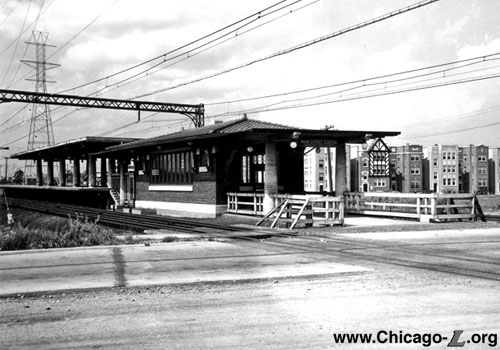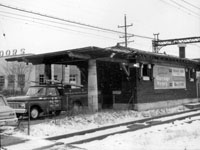
The Prairie School/bungalow style Main station is seen looking northeast on June 12, 1930. Unlike the other ground-level stations on the Niles Center branch, Main's headhouse was at street level with stairs behind up to the platform. Main was one of the few Niles Center stations with some population density near it, as evidenced by the apartment buildings visible in the background. Still, there was insufficient population to justify rapid transit service.
For a larger view, click here.
(Photo courtesy of M.D. McCarter, Collection of JJ Sedelmaier Productions) |
Main
(4900W/8400N)
Main Street and Skokie
Blvd., Village of Skokie
Service
Notes:

|
North Side
Division, Skokie branch
|
Quick Facts:
Address: TBD
Established: March 28, 1925
Original Line: North Side Division, Niles Center branch
Previous Names: n/a
Skip-Stop Type: n/a
Rebuilt: n/a
Status: Demolished
History:
Main Street station was built as part of the Chicago, North
Shore & Milwaukee Railroad's Skokie Valley Route, a high-speed
bypass for the interurban around the more congested North Shore
suburbs. The North Shore Line never used this stop, however -- though built as part of the Skokie Valley Route project, it was intended as a local stop for "L" trains. The Chicago Rapid Transit Company (CRT), owner and operator of the "L" at the time, had trackage rights on the line
and operated local service to intermediate stations between Howard and Dempster, including Main. Both the North
Shore Line and CRT were owned by utilities magnate Samuel Insull.
Arthur U. Gerber, staff architect for Sam Insull, designed the
facility. Nearly identical to the other local ground-level stations on the Niles Center branch between Oakton and Crawford (inclusive), Main was also similar to the still-extant Dempster station at the end of the line, only smaller and set between
the tracks with a single high-level island platform projecting from
the rear of the station house.
The Main station's architecture was an interesting mix of styles.
While the building could be classified as Prairie School based on
its intricate eaves and bracket work, low-pitched roof, multi-paned
casement windows and strong horizontal lines, closer examination of
the structure indicates that elements such as its textured exterior
brickwork and elaborately bracketed eaves with exposed rafters more
closely classify the building as belonging to the bungalow vernacular
style, a building type popular at the time with residential
development at the time but rarely seen in rail stations.
The exterior was executed in dark textured brick with a foundation,
belt course (through the windows) and plain slip windowsills of light
cast stone. The station had a low-pitched hipped roof with
an overhanging eave on all sides and projecting from the front, creating a
porch supported by a pair of massive tapered cement posts. The
windows along the side elevations had a typically Prairie School
design, with a long band of ten tall, narrow, vertical
casement windows flanked on the ends by smaller square nine-paned
windows. The rear of the station differed from the other Niles Center stations: whereas the others had a boarding platform that continued out from the back door and a station house roof that extended over the platform as a canopy, Main's platform and canopy were separate structures from the station house. This is because the other stations south of Main were designed with the station houses elevated to platform level with a short set of stairs in front of the station house. Main's station house, however, was situated at ground level, with a short set of stairs beyond the back door that brought passengers up to the island platform. The platform had a flat canopy supported by wooden rafters held up by two rows of tapered cement columns. Exposed rafters and wooden brackets under the eaves filled out
the exterior decoration and a signature Gerber touch included globe
lamps under the eaves and platform canopy.
The interior was small, simple and open, but still quite attractive. It
included a floor, brick walls with cast stone sills, and wooden
moldings. The modest interior functioned as a waiting room.
The Niles Center branch and Main station opened for service on
March 28, 1925.

The abandoned Main station is seen looking northwest on March 26, 1964, almost 39 years to the day after it opened. It had been closed for a day shy of 16 years at this time, and would be demolished soon after the photo was taken. For a larger view, click here. (CTA photo, Graham Garfield Collection) |
The station's history over the next couple decades was fairly
unremarkable. Within just a few years of the opening of the Skokie
Valley Route and the CRT's Niles Center local service the Depression
hit. New construction in the suburb virtually halted. Although some apartments were built northeast of the station, much of the land around the Main station was vacant -- though it had been subdivided with roads and sidewalks laid out and utilities installed, there were few buyers and little construction. By the time the
Chicago Transit Authority took over in 1947, the Niles Center branch's prospects for high (or even respectable) ridership levels
were still dim. The hoped-for development of Niles Center was
squelched by the Depression just a few years after the line opened,
and remained unfeasible through World War II. After assuming
operation of the "L" system, the
CTA studied each rapid transit
line and monitored each station. Then, bit by bit, they closed the
stations and lines that were most uneconomical and had the lowest
ridership to concentrate on the stronger routes. The Niles Center branch fell victim to this systematic pruning when on March 27, 1948,
service between Howard and Dempster was replaced by the #97 Skokie bus route. This date was chosen in
large part because it so happened that the North Shore Line's employees went on strike on this date -- one of several NSL strikes
of the 1940s -- meaning that the Skokie Valley Route was not staffed,
preventing the Niles Center branch from operating. Service had to be
suspended on the branch due to the North Shore Line strike anyway, so
it was a convenient opportunity served to drop a service that was
marginal at best.
The North Shore Line continued to operate on the Skokie Valley
Route but did not provide service to Main station, which remained
shuttered and abandoned. The Chicago North Shore and Milwaukee Railroad ceased
operation in the early morning hours of January 21, 1963.
In 1963, following North Shore Line abandonment, the
CTA began work to convert the
Skokie Valley Line as far north as Dempster to a new rapid transit line. The Transit Authority planned to resume
"L" service over the line, though rather than a local branch service
it was envisioned as a nonstop shuttle between Dempster and Howard. The "Skokie Swift", as
it was dubbed, opened to the public on Monday, April 20, 1964.
However , when the Skokie Swift was inaugurated in 1964, no station
was established on this site, despite the fact that the area had developed with
residential construction, like much of Skokie, thanks to postwar baby
boomers. The station torn down in 1964, due to the building's close proximity to Main Street representing a visual obstruction of autos and pedestrians for the motormen of Skokie Swift trains, which flew through the crossing at high speed on their nonstop run.




